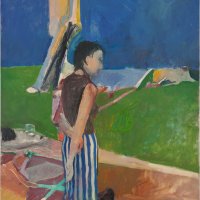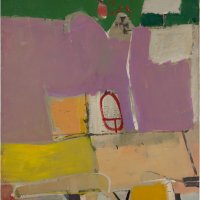Manafon (2009) by David Sylvian
“Sculpture must always obstinately question the basic premises of the prevailing culture. This is the function of all art, which society is trying to suppress… “ – Joseph Beuys (quoted in Michael Archer’s Art Since The 60s, Thames & Hudson, 2002)
In 2009 David Sylvian reactivated his solo career. He was bearded, long-haired, and dangling a dead hare from one clenched fist (if you believe Manafon’s inner sleeve portrait by Atsushi Fukui). Ruud Van Empel’s disquieting forest scenes, Study in Green no. 1, 5, 8 (2003) and Study in Green no. 16 (2004) strangely lit, and skewed of perspective were the cover art. Contemporary interviews made mention of Sylvian’s retreat to a hermitage in the woods. The whole package seemed to suggest that in the time since 2003’s Blemish David Sylvian had become pop’s own Unabomber.
To the casual Sylvian-watcher, the bomb was about to go off; what was hidden in the grooves of the record was not standard pop fare. From Manafon’s opening moments: what sounded like a tabletop being scraped with an upturned cup it was obvious the comfortable dynamics of pop had been dispensed with.
Small Metal Gods begins with a collision of aural textures: acoustic bass lopes forward and occasionally rubs up against muted studio chatter, the crackle of old vinyl and what sounds like someone playing sheet aluminium with paint brushes. Then the vocal comes in. David is reaching for something – it’s almost a shout. “It’s the farthest place I’ve ever been; it’s a new frontier for me.” The voice is hoarse. Behind it, the bass continues its slow progress, and the other instruments do their fragmentary thing, finding a space for themselves in the mix. His voice is naked and vulnerable – the music not so much accompanying as undermining it. There’s no cohesion. This is not the attack of pop. There are no verses in Small Metal Gods, no choruses, just tiny incidents: nothings, voids, uncertainties. A chorus of voices humming oohs and ahs forms a melodic coda as the song fades out.
Back in 2009 Small Metal Gods was seen as the most commercial track on the album, and a video was shot to accompany it. David didn’t appear. Instead a host of miniature passenger jets etched slow flight paths around the interior of an apartment.
There is no precedent in pop for the material on Manafon. The instrumentation was entirely improvised in the studio, David later gently tweaking it and adding improvised vocals. The resulting music is fragmentary, like a rustic, malign hip-hop with no beats. There are snatches of sounds, notes that threaten to coalesce into melodies, but they hover forever on the brink – never taking that step.
In other moments, the strums, plucks, bleeps/ scrapes and voice knot together, only to unravel the next moment leaving nothing but a memory of their meeting.
If it wasn’t for the mix of players: Berkhard Stangl (guitar), Werner Dafeldecker (acoustic bass), Michael Moser (cello), Christian Fennesz (laptop, guitar), Toshimaru Nakamura (no-input mixer), Otomo Yoshihide (turntables), John Tilbury (piano), Evan Parker (saxophone), Marcio Mattos (cello), Joel Ryan (live signal processing), Keith Rowe (guitar), Franz Hautzinger (trumpet), Tetuzi Akiyama (electric and acoustic guitar), and Sachiko M. (sine waves), and David Sylvian’s prominent vocals the album would maybe sound like straight jazz improvisation.
Instead, the tropes of pop song-writing and improvisatory music lie smashed on the floor of David’s cabin. More interesting as shards. David Sylvian describes Manafon as modern chamber music. I think it’s more like a form of sculpture, where the art is not in the composition, but in the act of bringing diverse elements together and allowing them simply to coexist. (When he was asked what he would be contributing to the early recording sessions, David said, “Nothing.”) In this, Manafon reminds me of the work of Joseph Beuys: his installations of fat, felt, lead or stone augmented with chosen objects like hats and dead flowers. Each element brings with it associations, references that reach beyond the work into the wider world. They create a two-way transmission: the associations enrich the work and the work enriches the world. Manafon works in the same way: the noises and notes standing in for Beuys’s physical materials.
There’s an open and ‘vulnerable‘ humanity to Beuys’s work that’s also present in Manafon. On Manafon, a sense of withdrawal informs the central aesthetic. This sense is made acute by the disconnect between voice and instrumentation and the fact that most of the songs are not “about” the singer; they’re third-person narratives. Both have a distancing effect. And yet the loneliness, the isolation seems all the more personal for the absence of autobiography. Perversely, by seemingly withdrawing from his work, David Sylvian has made his most intimate album to date.






Nice review. I was a big Japan fan as a kid and went to see them on the Tin Drum tour when I was 14 but I’ve never really bonded with Sylvian’s solo work. Might give it another go, now; I’m definitely going to check out the video with the tiny planes – sounds great! Cheers.
A link to the video’s embedded in the above text…
P.S. Big Beuys fan, too; liked the comparison.